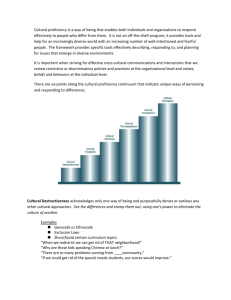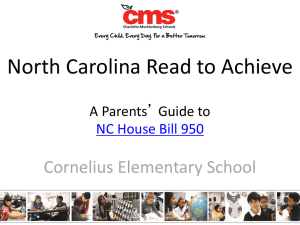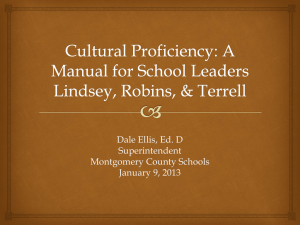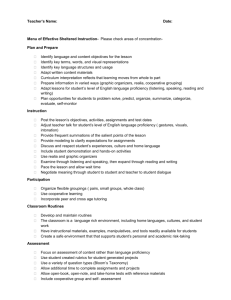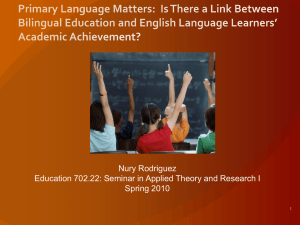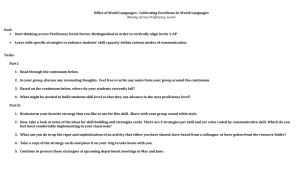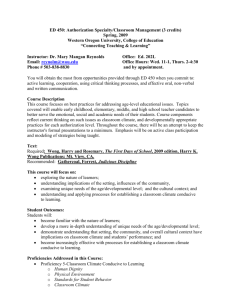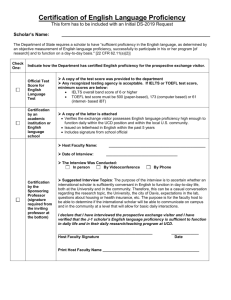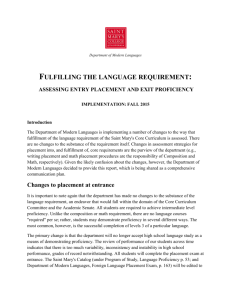C p 101 script - Cultural Proficiency Wiki
advertisement
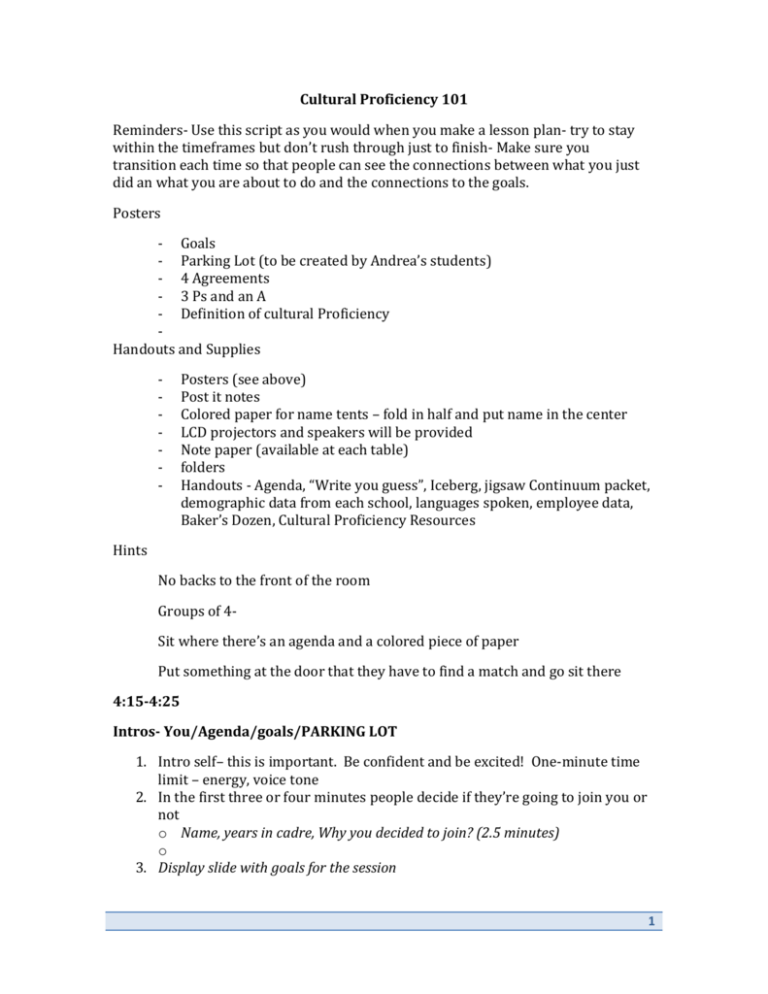
Cultural Proficiency 101 Reminders- Use this script as you would when you make a lesson plan- try to stay within the timeframes but don’t rush through just to finish- Make sure you transition each time so that people can see the connections between what you just did an what you are about to do and the connections to the goals. Posters - Goals - Parking Lot (to be created by Andrea’s students) - 4 Agreements - 3 Ps and an A - Definition of cultural Proficiency Handouts and Supplies - Posters (see above) Post it notes Colored paper for name tents – fold in half and put name in the center LCD projectors and speakers will be provided Note paper (available at each table) folders Handouts - Agenda, “Write you guess”, Iceberg, jigsaw Continuum packet, demographic data from each school, languages spoken, employee data, Baker’s Dozen, Cultural Proficiency Resources Hints No backs to the front of the room Groups of 4Sit where there’s an agenda and a colored piece of paper Put something at the door that they have to find a match and go sit there 4:15-4:25 Intros- You/Agenda/goals/PARKING LOT 1. Intro self– this is important. Be confident and be excited! One-minute time limit – energy, voice tone 2. In the first three or four minutes people decide if they’re going to join you or not o Name, years in cadre, Why you decided to join? (2.5 minutes) o 3. Display slide with goals for the session 1 By the end of the session we will: o Define culture and its impact on our daily lives. o Gain a better understanding of Cultural Proficiency and the Cultural Proficiency Continuum and how it affects our lives. o Provide district data and available resources for Cultural Proficiency o To ensure common language and a common understanding of this work about culture and learning 4. Describe the parking lot 4:25- 4:30 Do opening slides ( 4-7) These slides 4:30- ( slide 8) 3P’s and an A- , Four Agreements, Norms1. While one partner reads the information on the slide the other partner will post the signs. 2. You and your partner should also choose a quiet signal and introduce it to the group at this point. 3. Have the practice at least the probe quickly 4:30- 4:45 Warm- Up Perceptions Count- Find someone who you do not know well- this is important.. that they are not sitting with someone they know these things about- so they might have to move!!!! 1. ( Slide 11) Allow the participants 2 min to write down perceptions about each other 2. Tell them to share with their partners (2-3 minutes to share and 3. 3-5 minutes to share out.- how many had many right? 4. What influences your answers? 5. What surprised you? Did you have anything in common? 6. *****Use 3Ps and an A as you’re sharing. What happens to our students related to this? Transition-Now that we have seen a window into how perceptions can be off base, let’s investigate what culture is and how culture impacts how we are in the world and how others view us. 4:45- 5:00 What is culture? Think- Pair- Share- (Remind audience that this is a strategy that can be used in the classroom.) 1. Show (slide 13)and have the jot ideas down 2. Distribute Iceberg after they write (slide 14)(Do not hand out iceberg handout until the slide appears 3. Have them circle any markers that they did not list in their brainstorm (slide 15) 4. Discuss one or two “markers” (that they did NOT think of when they brainstormed) 5. Hear some of them. 6. Give them a Definition of Culture (slide 16 or 17- Asa Hilliard one) 7. (Slide 18) Cultural Groupso They could talk about one of the markers related to ONE of the cultures with which they identify (if you feel this is going well… i.e. African American, Jewish, teachers, young people, over 50 8. Closure- (slide 19) We have come to a common understanding about culture – what it is what it means. o turn to your neighbor and tell them your new ideas about culture before we view a video that demonstrates some of the effects of culture in our society Transition: Before they view explain what you want them to get out of it- how culture plays out in our society sometimes- how people react to people whose culture is different form theirs. 5:00 – 5:20 Video- _Prime Time – “What Would You Do?”_____________________ 1. Introduction – we will view a video how cultures plays a role in interactions among people. Speaker- as you watch the video- think about what resonates with you? 2. After- In pairs – What moved you/resonated for you about this video and what can you take away- what will you take away 3. -Have people take some time to write down their reactions and share with a partner (might be time for them to find someone new in the room – walk over to them and share) Transition-Now that we have seen a video that______________________________________We will talk about the tools of cultural proficiency – something we all should want to pursue 5:25 – 6:00 Cultural Proficiency Tools- distribute the continuum packet 1. Introduce the Tools – quickly (slide 21) 3 2. Show Continuum (slide 22) 3. Show next (slides 23-25) about why cultural proficiency in these times (THIS IS A CHANGE From OUR MEETING- THEY NEED TO UNDERSTAND WHY BEORE THEY READ THE OTHERS- I THINK, you decide) 4. Show slide with directions (slide 26) 5. Check for understanding of directions 6. (Slide 27) When you stop the reading and start the jigsaw teaching – model one 7. Make sure that your give each person the time limit – YOU PUT UP THE SLIDE OF THE POINT YOU WANT TAUGHT (Slides 28-30) – to keep them on target) to teach so that one group will not finish quickly and others not. ( 2 minutes for each to teach – tell them to make sure that all understand- ask questions 7. Have all read proficiency (slide 33, 34) -Discuss proficiency – show the slide and underline on the handout Define Cultural Proficiency- again 1. Show slide and definition on their handout 2. Tell them we will come back to this again at the end of the session after we explore the continuum. Transition- ( something like this……. we know that we are all on the journey to proficiency and we want you to have one more reason to join us.. the students we serve often look different than the staff who are teaching them. This fact presents a reason for teachers to learn another set of skill- CP skills -if they are to ensure the success of each student-) 6:00-6:10 –Why become culturally proficient? - the data 1. Show the data slides and have them look at them a. Ask what they think the data of their school is related to the different ethnicities in the school /district b. have them meet with partners who are not in their school to compare c. Discuss - Data- Why? List what they think are the causes – note if they are all outside of our influence d. Refer to strategic plan goal 6:10- 6:15 Ending -3.2.1. 1. Go back to the tools- show that we only covered the continuum todayand that we have a lot further to go in the journey… 2. Write down 3 things you learned from this session, 2 questions you still have, and 1 thing that surprised you. Have a brief closure- statement a. ask a few people what they learned today……….or b. Have them turn to a neighbor and read their 3,21 (This is also a strategy that can be used in the classroom.) non-fiction or fiction topics. In closing mention remaining slides… Statements from Dr. Asante and Dr. Mazama Watch your thoughts….etc. Summary Be the change you expect in others. GOOD LUCK AND……. YOU HAVE THE SKILL TO BRING PEOPLE IN!!!!!!!!!! luvbmw 5
